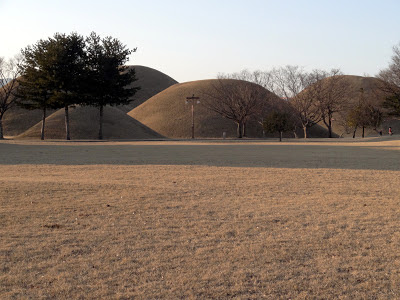It's an interesting city, like Taipei on speed, and the people are interesting too. The thing that struck me most was how, if the ill-nourished North Koreans were ever to dig one of their infamous invasion tunnels all the way to Seoul, and emerge suddenly onto the streets and into the homes and workplaces of the South Koreans, the latter would take them down with one hand tied behind their backs.
You see, it was really cold. Have I said that already? Yet there seemed to be some kind of competition going on about who could be the least dressed to withstand it. I was wearing thermal underwear, top and bottom, and as many layers as would fit under my coat, plus hat, scarf, gloves and hood over my hat, and I could stand about an hour at -12 degrees before retreating indoors. But all around people were sporting little more than maybe a leather jacket and a hat, and looking mildly chilled.
The other thing that gave me the impression South Koreans are tough was the shoving. If you're in the way, people make no effort to avoid body contact as they pass, so in crowded situations you're constantly bumped into, pushed and shoved. I was starting to think dark thoughts about thumping the next person who shoved me when I realised it was nothing personal. It's just a lack of preciousness about body space and contact. For example, on the subway the seating is so close that people of average size are forced to sit squeezed shoulder to shoulder and thigh to thigh with complete strangers, but no one minds.
So, South Koreans - a little bit scary.
We did a few 'must do' things, such as visit Gyeongbokgung, one of the royal palaces.
The weather had thinned out the crowds nicely.
It's a huge site, all the more impressive for the fact that it's a fraction of its former size, and it was fascinating to see how the royals and their entourage and officials had lived all those centuries ago. The only thing that was a little frustrating was the lack of information. Unless we missed something there were no pamphlets explaining anything, either in English or Korean, and only a few signs to explain the use of a building.
One of the few informative signs told that this was the royal banqueting hall and is the largest elevated pavilion in Korea. Three bays at the centre of symbolise heaven, earth and man, and the twelve outside bays symbolise the 12 months of the year.
The empty space in the foreground is a drained pond. In summer the aristocracy and visiting dignitaries would go boating.

 We also went to Namsongol Hanok Village, which was more satisfying, as there were rooms full of contemporaneous objects and furniture, giving a real insight into daily life for well to do Koreans more than a century ago.
We also went to Namsongol Hanok Village, which was more satisfying, as there were rooms full of contemporaneous objects and furniture, giving a real insight into daily life for well to do Koreans more than a century ago.The pond was frozen solid.
The onsite time capsule was very interesting too. Built in 1994 on the 600th anniversary of the founding of Korea, it's due to be opened again on the 1,000th anniversary.
My husband went to the Demilitarized Zone one day, while I opted for the safer option of taking our son to an amusement park. DMZ tours are well worth doing, but not at all suitable for children, not only because of the stories told of people dying in border skirmishes, but also because in some areas there's a tiny but real risk of being shot at.
Ice-skating was more fun.
On the day I lost to food poisoning, and my husband and son went to the War Museum, so lots more death and destruction there. They loved it.
Food was, on the whole, good. Streetfood in particular was delicious. We sampled yakatori, a kind of cake thing with an egg in it, and what I thought was bulgogi. On looking up bulgogi I realise what we had doesn't fit the description, even though that's what the stall sign said. Whatever it was, it tasted great. Plus, the stallholder was making new ones and serving at the same time, so we got a free cooking demonstration, too.
 |
| Eggy cake things being made. |
 |
| And eaten. |
 |
| Thing that called itself bulgogi. |
Roast chestnuts were an unexpected treat to remind us of home.
 |
| If they could leave out the toxic bacteria, that would be great. |
We had what I thought was a great restaurant meal, only to find out the next day my stomach disagreed with my opinion.
It was the nearest dish that did it.
On our final day we had a disappointing trip to Gyeongju. Looking at the tourist information for this town I could hardly believe we were in the same place. We took a map from the station tourist centre, so we knew where things should be, but the town's sights are so well hidden behind shopfronts that we literally could not find them. There were no street signs, either.
We did stumble across some ancient royal tombs, which were pretty much unavoidable, but unfortunately our last day was a bit of a let down.
The brown colour is representative of the South Korean winter landscape. It looks as though the entire countryside is a sepia photograph.
On the whole we enjoyed most of our South Korean holiday, but personally I was also very happy to come back to calmer, and warmer, Taiwan.
























